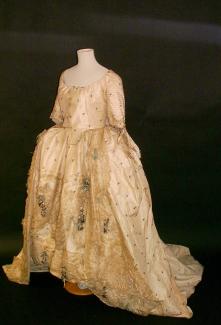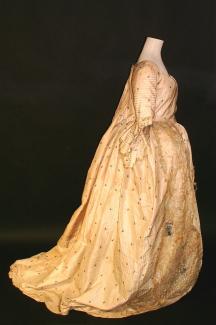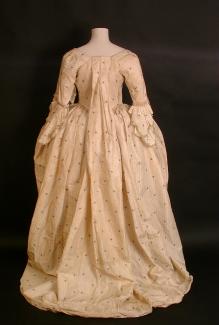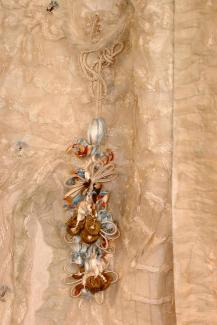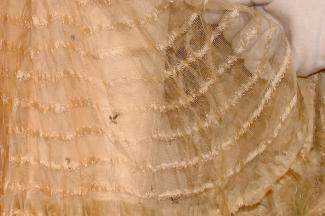We are most fortunate to have in the collection a glorious 18th century late rococo gown in the form of a sack-back dress, styled as an open robe, with its own original matching outer petticoat. The fabric is a lustrous lightweight silk taffeta, probably that known in contemporary diaries as ‘lutestring’ or ‘lustring’. It has a very fine rib and self stripe, and is further embellished with a small scale flower motif. It dates to c1775.
Such a silk is known as a brocade - the floral motif at first appears embroidered, but the regularity of the repeat and loose weft threads on the reverse indicate that it is a woven pattern. The naturalistic floral design is typically English. Many such silks were woven in Spitalfields in London, and a good number from the 1740s were designed by a female, Anna Maria Garthwaite.
This dress has blue stripes in the selvedge which is consistent with its being a Spitalfields silk. The gown and petticoat are, of course, entirely hand-sewn. The sack-back was first introduced as an informal style from France, where it was known simply as ‘le sac’, and later colloquially as ‘the Watteau pleat’ after the French artist who famously painted ladies in these full-backed, sack-like gowns. This style is also sometimes called the ‘robe a la francaise’. The sack-back style became increasingly formal after the mid century, in England and across Europe. The sack is formed of inverted pleats hanging from the back neckline, very wide and full early in the century but the pleating gradually becoming tighter and more confined, just four inches or so wide, and then caught down for two or three inches to the under fabric, by this date.
The closed front bodice is typical of the 1770s. The gown has a small train, which was usual for formal wear of the period. A matching petticoat also indicates its formal status. The gown would have been worn over a hoop or hoops (sometimes known as ‘panniers’ from the French word for basket). The exact shape of the skirt and size of hoop can be determined from the construction of the gown with its wedge-shaped pleats to the hips. There is also evidence of the outer skirt having originally been looped up with ties, into the ‘polonaise’ style fashionable in the 1770s.
The high quality and finish of the dress suggests that it was designed to be worn for a very special occasion. It may have been a wedding dress: there are gowns and petticoats of a similar date in the Victoria and Albert Museum collection (including two dated c.1775-80 T180&A-1965, hand-embroidered silk satin, French, and T2-1947, plain white satin, English, both thought to be wedding or betrothal gowns) and the designer of the costumes for the 2007 film, The Duchess, Michael Connor, clearly took inspiration from such gowns for his wedding dress for Keira Knightley playing Georgiana Cavendish, Duchess of Devonshire at her wedding in June 1774, which he himself has described as “a creamy silk with lots of decoration”. Wedding dresses at this period were in fashionable, rather than retrospective styles.
Some dresses of this period have been kept by families for generations, in near pristine condition; others were altered and reused thereafter, sometimes more than once. Indeed many 18th century dresses have survived through extended use as fancy dress, both in the 19th and the 20th centuries. The cost of clothing for non-Royal weddings was becoming a sizeable consideration by this date. Mrs Nollekens, wife of a famous 18th century sculptor, married in 1772 in “a sacque and petticoat of the most expensive brocaded white silk, resembling net work, enriched with small flowers” (from “Nollekens and his times” by J T Smith, 1828). The marriage wardrobe cost about two hundred pounds (albeit this included at least two other dresses). Fly braid, described as fringe, bought by Barbara Johnson from a haberdasher cost “eight shillings a dozen” (yards) in 1762. There are some fashion illustrations that suggest that very elaborate dresses were worn for balls and dancing, opera-going and promenading, and even card-playing in this period. The most elaborate gowns of the period were worn at Birthday Balls at Court, which in George III’s reign were sumptuous affairs, or indeed for presentation at Court, when ladies of wealth and influence met the monarch at Drawing Rooms. Mrs Delany describes how at Court there was “a great deal of finery”. She described with relish the dress at the Court occasions that she attended. In the 1750s and 60s the mantua was the appropriate style, but by the 1770s and 80s the sack-back was acceptable, worn closely fitting to the body, and with the train held, but not looped up. Smaller hoops forming a bell shaped silhouette were usual at this date for formal wear, and were gradually being ousted from everyday fashion, but square hoops were still worn, in an increasingly fossilised fashion, at Court (indeed, hoops continued to be worn at Court until 1820). The trimmings on this gown and petticoat are deliciously extravagant. Here we have a profusion of gauze, feathers, lace and tassels, which embellish an already prettily figured silk. Dense, narrow gauze strips in ‘eau-de-nil’ (literally, water of the Nile, a pale turquoise colour) are used to decorate various borders, and the ?egret/osprey feathers are dyed in ‘eau de nil’ to match.
Swathes of fine blond-coloured silk lace characterised by a narrow stripe which echoes the dress silk are festooned across the fronts of the petticoat and skirts of the gown. The tassels are formed around light wood moulds, with wire shaping to create flower forms, from which knotted and tufted raw silks in colours matching the woven motifs - and known as ‘fly braid’ - trail in organised confusion. Tassels were immensely popular in this period. A portrait of Queen Charlotte by Gainsborough, painted in 1781, shows tassels that are very like.
The sleeve cuffs are weighted with lead (like modern curtains) to ensure the correct set of the double sleeve flounces, which would have been dressed with tiered lace or lawn sleeve ruffles, probably three, simply tacked in and thereby removable for washing.
The bodice is lined with linen. The neckline has a gentle narrow addition of matching silk into which is inserted a drawstring which brings the bodice close in, and also allows for a muslin kerchief to be inserted across the chest for modesty and warmth, fastened with a fichu pin. The waist of the petticoat is also closed with a drawstring. The stomacher here is integral – it would be joined across the front of a pair of whaleboned stays, which in turn would be worn over shift which would protect the skin from abrasion and keep the dress clean. A lawn edging to the linen shift might show at neckline and cuffs.
